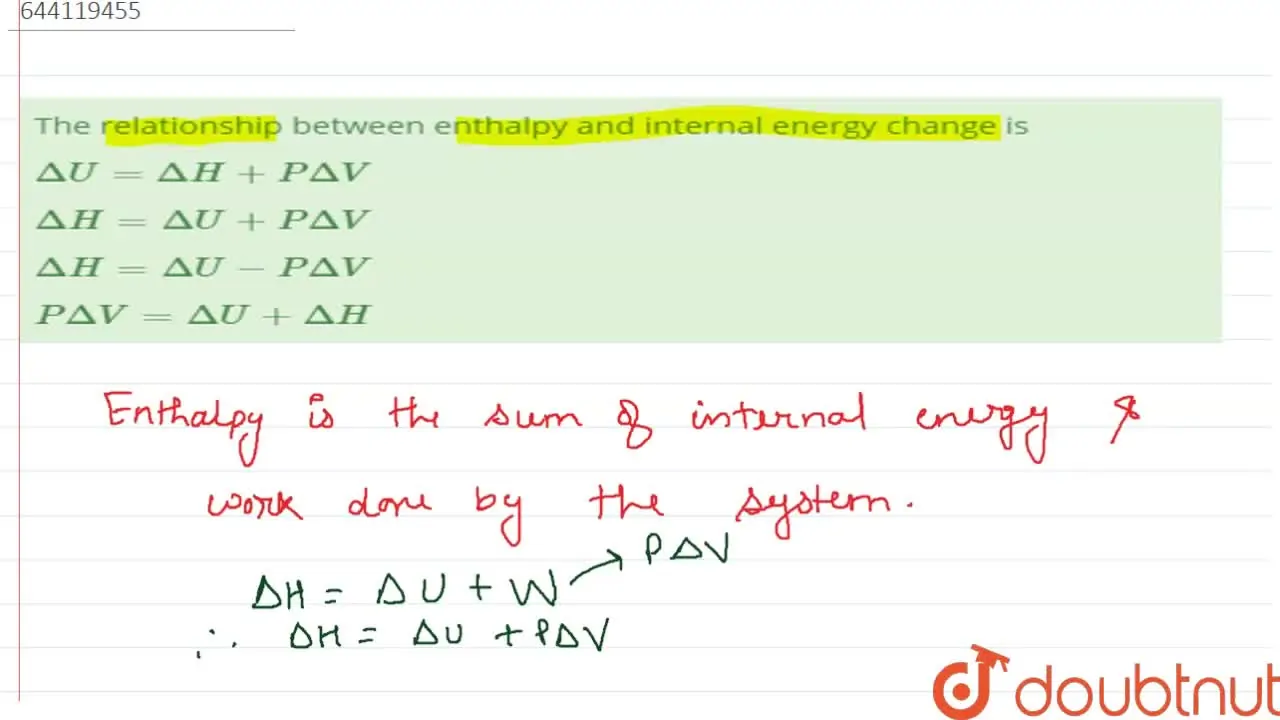The relationship between enthalpy and internal energy change is
We know, Path CA: Isothermal compression
Path AB: Isobaric expansion
Path BC: Isochroic change
Let Vi and Vf be initial volume and final volume at repective points.
For temperature T1(forC):PV−nRT1
2×10=1×0.0821×T1
T1=243.60K
For temperature T2 (For C and B):P1V1T1=P2V2T2
2×10T1=20×10T2
T2T1=10
T2=243.60×10=2436.0K
Path CA:w=+2.303nRT1logViVf
=2.303×1×2×243.6log101
=+1122.02cal
ΔE=−0 for isotermal compression, also q=W
Path AB,w=−P(Vf−V1)
=−20×(10−1)=−180L−atm
=−180×20.0821=−4384.9cal
Pth BC:w=−P(Vf−V1)=0
(∵Vf−V1=0) since volume is constant
For monoatomic gas, heat chnage at constant volume =qv=ΔU
Thus, for path BC,qv=Cv×n×ΔT=ΔU
∴qv=32R×1(2436−243.6)
=32×2×1×(2192.4)=65772.2cal
Since process involves cooling ∴qv=ΔU=−6577.2cal
Also in path AB, the initial enegry in state A and state C is same. Thus,, during path AB, an increase in internal enegry equivalent of change in internal enegry during path.
BC should take place. Thus, ΔU for path AB=+6577.2cal
Now q for path AB=ΔU−wAB=6577.2+6577.2cal
=10962.1cal
Cycle: ΔU=0,
q=−w=−[wpathCA+wpathAB+wpathBC]
=−[+1122.02+(−4384.9+0]
∴q=−w=+3262.88cal
Related Playlists
Similar Questions
The enthalpy change for chemical reaction is denoted as ΔHΘ and ΔHΘ=HΘP−HΘR. The relation between enthalpy and internal energy is expressed by equation:
ΔH=ΔU+ΔnRT
where ΔU= change in internal energy Δn= change in number of moles, R= gas constant.
Enthalpy of the system is given asView SolutionThe enthalpy change for chemical reaction is denoted aas ΔHΘ and ΔHΘ=HΘP−HΘR. The relation between enthalpy and internal energy is expressed by equation:
ΔH=ΔU+ΔnRT
where ΔU= change in internal energy Δn= change in number of moles, R= gas constant.
Which of the following equations corresponds to the definition of enthalpy of formation at 298K?View SolutionThe enthalpy change for chemical reaction is denoted aas ΔHΘ and ΔHΘ=HΘP−HΘR. The relation between enthalpy and internal energy is expressed by equation:
ΔH=ΔU+ΔnRT
where ΔU= change in internal enegry Δn= change in number of moles, R= gas constant.
H2(g)+(12)O2(g)=H2O(l),ΔH298K=−68.00kcal
Heat of voporisation of water at 1 atm and 25∘C is 10.00kcal. The standard heat of formation (in kcal) of 1 mole vapour a 25∘C isView SolutionThe enthalpy change for chemical reaction is denoted aas ΔHΘ and ΔHΘ=HΘP−HΘR. The relation between enthalpy and internal enegry is expressed by equation:
ΔH=ΔU+ΔnRT
where ΔU= change in internal enegry Δn= change in number of moles, R= gas constant.
Enthalpy of the system is given asView SolutionThe enthalpy change for chemical reaction is denoted as ΔHΘ and ΔHΘ=HΘP−HΘR. The relation between enthalpy and internal enegry is expressed by equation:
ΔH=ΔU+ΔnRT
where ΔU= change in internal enegry Δn= change in number of moles, R= gas constant.
For the change, Cdiamond→Cgraphite,ΔH=−1.89kJ, if 6g of diamond and 6g of graphite are seperately burnt to yield CO2 the heat liberated in first case isView SolutionThe enthalpy change for chemical reaction is denoted aas ΔHΘ and ΔHΘ=HΘP−HΘR. The relation between enthalpy and internal enegry is expressed by equation:
ΔH=ΔU+ΔnRT
where ΔU= change in internal enegry Δn= change in number of moles, R= gas constant.
For a reaction, 2X(s)+2Y(s)→2C(l)+D(g),ΔH at 27∘C is −28kcalmol−1.ΔU is .....kcalmol−1View SolutionEnthalpy change equal internal energy change when
View SolutionFor the reaction PCl5(g)→PCl3(g)+Cl2(g) where ΔH and ΔE represents enthalpy change and internal energy change respectively.
View SolutionThe relationship between the free energy change (ΔG) and entropy change (ΔS) at constant temperature (T) si
View SolutionThe relationship between kinetic energy (K) and potential energy (U) of electron moving in a orbit around the nucleus is
View Solution


